Cathedral Cut Gemstones: Artistry and Value
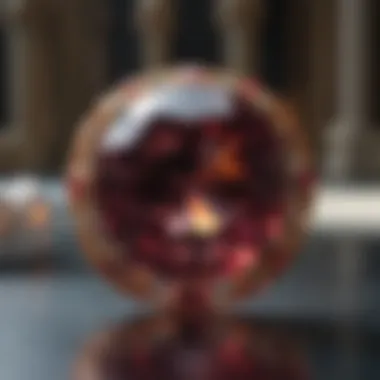
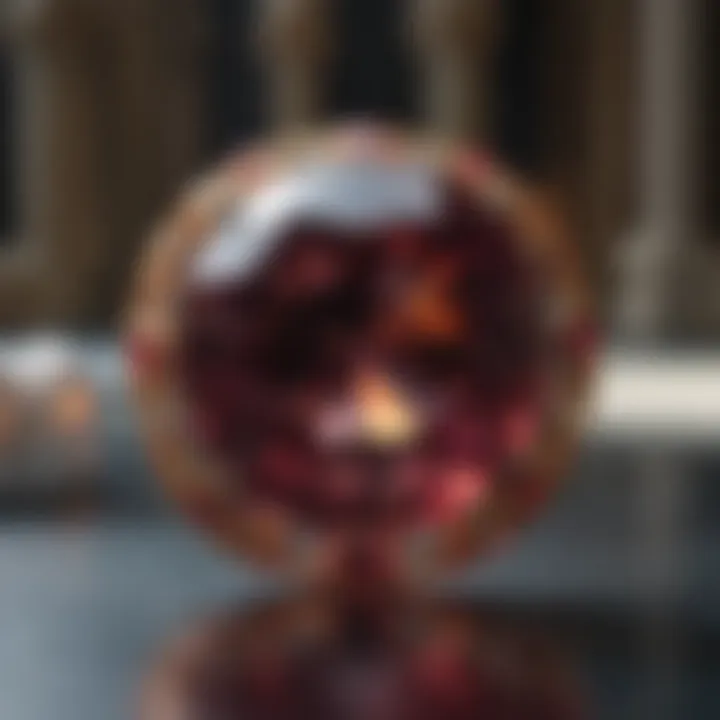
Intro
In the vast realm of gemstones, a few unique types stand out due to their exquisite designs and cultural significance. Cathedral cut gemstones, with their distinct architectural inspiration, are among the most captivating. Their striking looks draw the eye, but it’s the rich tapestry of history and artistry behind these gems that truly enchants collectors and enthusiasts alike. This deep-dive will guide you through their essence, explore historical context, and reveal how to appreciate these unique stones better.
Gemstone Overview
Definition of Gemstones
At the heart of this exploration lies the question: what constitutes a gemstone? Generally speaking, gemstones are naturally occurring minerals that possess beauty, durability, and rarity. They are often polished and cut to enhance their natural properties, turning raw crystals into shimmering works of art.
Cathedral cut gemstones, specifically, are a subcategory that combines elements of craftsmanship and design. The cut highlights the stone’s brilliance and depth, bringing out an enchanting play of light that often mirrors the intricate facades of cathedrals.
Classification of Gemstones
Gemstones can be broadly classified into two main categories: precious and semi-precious stones. Precious gemstones, such as diamonds, rubies, sapphires, and emeralds, are esteemed for their extreme rarity and enduring value. On the other hand, semi-precious stones encompass a wider range of materials, including amethysts, topazes, and garnets.
Cathedral cut gemstones can be found among both categories, with emerging techniques enabling various stones to be shaped into this captivating cut. Jewelers and designers often focus on the interplay of light and shape, creating a piece that is not only a gemstone but an experience in itself.
"The architectural elegance of cathedral cut gemstones transports one back to a sanctuary of artistry, where nature's handiwork is celebrated and revered."
Historical Significance
Origins of Gemstone Use
The use of gemstones dates back thousands of years, with early civilizations employing them not only for adornment but also for their believed mystical and healing properties. The allure of these stones has continuously captivated human societies.
Initially, gemstones were used in religious contexts, often to represent power, divinity, or protection. This is where the roots of cathedral cut gems may find their inspiration, reflecting the divine beauty seen in the architecture of historical cathedrals. Just as grand cathedrals served as temples of spirituality, so too did the gemstones enhance their sacred spaces.
Cultural Insights: Gemstones in Ancient Civilizations
Across ancient civilizations, one can find fascinating tales of gemstone usage. In Egypt, turquoise and lapis lazuli were crafted into exquisite jewelry pieces, while in Mesopotamia, gemstones often found their place in royal regalia.
In these historical contexts, gemstones weren't just for show; they were symbols of status and wealth. The choice of stone often reflected personal beliefs and cultural significance, aligning closely with the practices of the time. This rich history encourages modern collectors to view cathedral cut gemstones not just as material objects, but as carriers of fascinating stories.
Understanding the captivating history and cultural significance behind gemstones elevates the experience of collecting and appreciating them. As we move forward, let’s delve deeper into the design principles of cathedral cut gemstones, revealing the artistry and technique embedded within each facet.
Understanding Cathedral Cut
The concept of Cathedral Cut gemstones is not simply a trend in the jewelry world; it's an embodiment of artistry fused with geological marvels. Understanding this particular design is essential for anyone interested in gemology or artistic jewelry. Cathedral Cuts resonate with a sense of depth, capturing light and emotions alike. These gemstones often serve as centerpieces that draw admiration and provoke curiosity in the observer.
Defining Cathedral Cut
The Cathedral Cut stands out among its peers like a rose among daisies. It's characterized by its long, elegant facets that taper down to a pointed base, mimicking the grandeur of a cathedral’s arches. A notable aspect of this cut is its ability to maximize light reflection, which results in intense brilliance. The broader, crown-like top and intricate faceting lend it an air of sophistication, making it an appealing choice in fine jewelry. Understanding this design is crucial as it sets the stage for appreciating its delicate beauty.
Historical Context
Origin of the Cathedral Cut
The inception of the Cathedral Cut can be traced back to the late 19th century when jewelers began exploring more creative designs. This cut was born out of a desire to replicate the soaring arcs of gothic architecture found in some of the world’s most stunning cathedrals. Its name not only reflects its appearance but also pays homage to the rich architectural heritage that influenced it. The intricate design allows for the gemstone to sparkle in shades reminiscent of stained glass windows, making it both a historical and aesthetic marvel. The popularity of this cut lies in how it channels a timeless elegance, connecting the beauty of natural gemstones to the artistry of human creation.
Evolution of Designs
As with any art form, the Cathedral Cut has evolved over the decades. What started in intricate depictions from a bygone era has transformed to include modern variations embracing minimalism. Jewelers today leverage advanced technology to further enhance the cut’s luster and precision. The contemporary versions might incorporate softer facets or different shapes, proving that adaptation is key in the world of gemstones. This evolution keeps the design relevant and appealing, bridging old influences with new ideas.
How Cathedral Cut Differs from Other Cuts
Comparison with Brilliant Cut
When comparing the Cathedral Cut with the Brilliant Cut, the distinctions become clear quite quickly. The Brilliant Cut emphasizes maximizing sparkle through a multitude of facets, but often sacrifices some of the depth that the Cathedral Cut boasts. On the other hand, Cathedral Cut offers a more pronounced depth effect, allowing for a different light interaction and a dramatic visual impact. Enthusiasts appreciate the Cathedral Cut for its ability to evoke emotion and convey a sense of history and opulence, along with its deeper, candlelit glow that is somewhat unique to its design.
Unique Characteristics
What really sets Cathedral Cuts apart are their strong visual lines and shadows. They're often described as capturing "the dance of light" in a way that other cuts may not achieve. The elongated facets create a sort of depth perception and architectural resonance that many other cuts lack. Furthermore, they are less common on the market, making them a prized possession among collectors and a noticeable statement piece in any jewelry collection. This uniqueness adds to their allure, offering not just a pretty stone, but a conversation starter steeped in art and history.
The Aesthetic Appeal
When it comes to cathedral cut gemstones, their aesthetic appeal is not just about appearance; it embodies a blend of artistry and craftsmanship that captivates many. The visually striking designs, especially the way they catch the light, create an engaging dialogue with the observer. This section digs into the elements that contribute to the allure of these gemstones, highlighting how they enhance both jewelry and personal expression.
Architectural Inspiration
Relation to Gothic Architecture
One cannot talk about cathedral cut gemstones without mentioning their roots in Gothic architecture. The intricate designs of Gothic cathedrals, characterized by pointed arches and detailed stone carvings, inspire the way these stones are cut. This relationship lends a sense of grandeur and elegance to the gemstones. The pointed facets mimic the spires that shoot skyward in many Gothic structures, capturing an architectural beauty.
Why is this significant? Besides aesthetics, it adds a layer of historical depth, connecting wearers to an era of rich artistry and craftsmanship. A cathedral cut gemstone, with its sharp points and refined angles, often features a unique reflection of light, creating an ethereal quality reminiscent of stained glass windows.
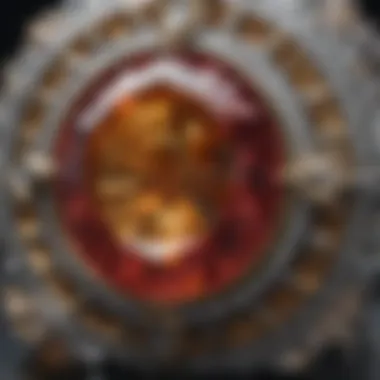
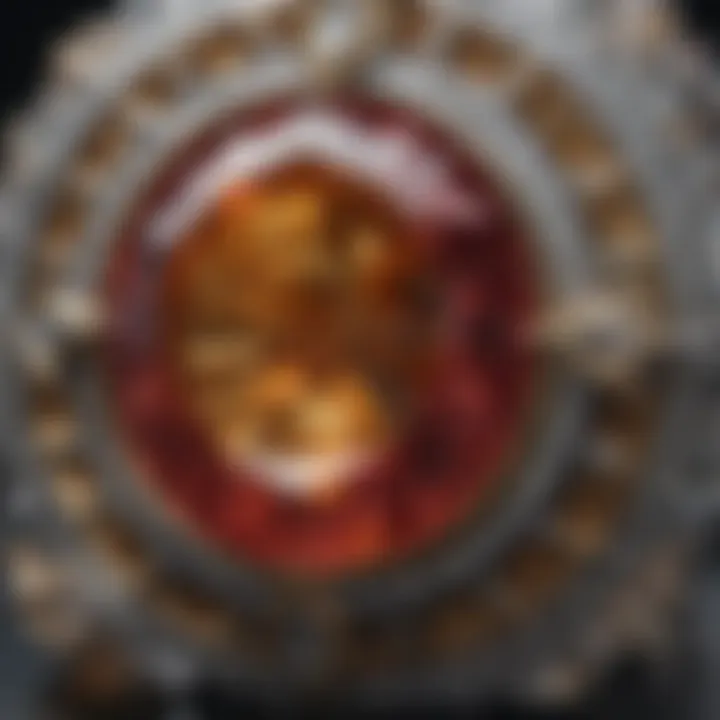
On the downside, the complexity of the cut can lead to higher costs, as more skill and time are required for each unique gem. However, the investment often pays off in visual brilliance and emotional connection.
Symbolism in Design
The symbolism attached to cathedral cut gemstones further enriches their appeal. Each cut serves a purpose, channeling light in a way that transcends mere aesthetics. For many cultures, these cuts signify clarity and purity, emulating the spiritual essence associated with religious buildings.
This symbolic nature adds a layer of meaning for the wearer, making it not just a piece of jewelry, but an item steeped in deeper interpretation. However, this can sometimes be misinterpreted, leading to confusion about the true value and significance of the piece.
Visual Impact
Light Reflection and Dispersion
One of the striking aspects of cathedral cut gemstones is their ability to reflect and disperse light beautifully. The intricate facets allow light to enter and exit the gem at various angles, creating a sparkling effect that can dazzle onlookers. This captivating play of light adds vibrancy to the gems, making them a popular choice for earrings and pendants, as they can catch the eye effortlessly.
Yet, one must consider that not every gemstone is equal in this regard. Some lower-quality stones may not reflect light effectively, which can detract from their overall visual impact. Therefore, selecting a gem of high clarity and cut quality is crucial for showcasing this brilliance.
Color Enhancement Features
The unique traits of cathedral cut gemstones also extend to their color enhancement properties. The symphony of light reflection and the geometry of the cut can accentuate the inherent hues of the stones. Gemstones like rubies or sapphires become even more alluring under the ingenuity of this cut, allowing colors to appear more vivid and dynamic.
However, one should be cautious. Not all gemstones showcase vibrant colors equally under this cut, and some may require additional treatments to achieve that level of enhancement. The balance between natural beauty and enhancement techniques can be a nuanced topic.
Matching with Jewelry Settings
Compatible Settings
Choosing the right jewelry setting for cathedral cut gemstones is essential for maintaining their intended aesthetic appeal. Engagement rings and pendants are popular settings, allowing the designs to stand out while complementing the stone. Metals like white gold or platinum work excellently, providing a sleek backdrop that enhances the sparkle of the gem itself.
However, compatibility should not be overlooked. Some settings can overshadow the unique features of the gemstone, making it crucial to choose wisely. A careful selection can enhance the overall visual impact, yet poor choices can diminish the beauty.
Personalizing with Other Gemstones
Adding complimentary gemstones to cathedral cut pieces can create a striking visual narrative. Mixing and matching with semi-precious stones can enhance your personal style. For instance, a cathedral cut diamond paired with light blue topaz creates a charming contrast that speaks volumes about individual taste.
Nonetheless, be mindful of balance. If additional stones overpower the cathedral cut gemstone, it can lead to a visual mishmash rather than a harmonious blend. Therefore, thoughtful pairing becomes a worthwhile investment in achieving a stunning aesthetic.
In summary, the aesthetic appeal of cathedral cut gemstones stems from their architectural roots, intricate lightplay, and thoughtful settings. With the right choices and an understanding of design principles, these stones can be a centerpiece, conveying beauty and significance to any piece of jewelry.
The beauty and intrigue of these gemstones go beyond their physical appearance and delve into deeper discussions about artistry, symbolism, and personal expression.
Cultural Significance
Understanding the cultural significance of cathedral cut gemstones reveals so much more than their beauty. It dives into how these gems resonate with meanings across various societies, shedding light on their role in traditions and values. Often, these gems are not just pieces of decorative art; they symbolize beliefs, history, and connections that stretch across generations.
Symbolism across Cultures
Religious Interpretations
In many cultures, gemstones hold deep spiritual meanings. For instance, in Christianity, gemstones are often associated with divine favor or protection. The cathedral cut, named after grand Gothic structures, evokes feelings of reverence and light. This cut’s intricate design reflects the architectural beauty seen in cathedrals, driving home its association with sacred spaces. Such connections make cathedral cut gemstones a popular choice for religious ceremonies or baptismal gifts. This intertwining of spirituality and art amplifies their importance, as they embody hopes and aspirations tied to faith.
One unique feature of religious interpretations lies in the way these stones can enhance a personal pilgrimage or journey of faith. People often carry or wear gemstone jewelry that depicts their beliefs, further solidifying the bond between the item and the wearer. However, it’s essential to recognize that as much as such gemstones symbolize faith, the exact meaning can vary significantly from one faith to another.
Cultural Heritage Representations
Cultural heritage representations encapsulate the stories and identities of communities. Cathedral cut gemstones can serve as tangible links to a community's past, often used in traditional ornaments or ceremonies. For example, in regions rich in gemstone mining, these cuts reflect not just craftsmanship but also a people’s connection to the land. The gleam of a cathedral cut gemstone might be reminiscent of a sunset behind ancient ruins in a mountainous landscape.
A standout feature in these representations is their ability to tell stories. Each gem carries with it the legacy of the artisans who crafted it, making them a cherished part of cultural heritage. This factor makes them beneficial for cultural appreciation as they evoke pride and preservation of history. However, the challenge arises in ensuring such masterpieces are produced ethically, as the lineage of a gem is often marred by modern exploitation and environmental concerns.
Cathedral Cut in Art and Literature
The influence of cathedral cut gemstones in art and literature cannot be understated. Poets have often invoked the imagery of stones and light to convey emotion and depth. Similarly, artists have used these pieces to symbolize struggle, beauty, and transcendence. In works of fiction, characters may gift or inherit cathedral cut pieces, imbuing them with narrative significance that echoes throughout the story.
Modern Interpretations in Design
Trends in Contemporary Jewelry
The modern trends in jewelry design have certainly embraced cathedral cut gemstones, steering them into the spotlight once again. People seek unique cuts that distinguish their pieces, and cathedral cut gems certainly fit the bill. These cuts allow designers to play with light in innovative ways, creating pieces that stand out both in form and sparkle. Moreover, the growing appreciation for bespoke jewelry has encouraged collectors to look beyond standard cuts, enhancing their appeal.
Unique features, such as the reflective qualities of cathedral cuts, mean that they can reinterpret traditional symbols of romance or celebration, bringing them into present-day contexts. However, the challenge often resides in finding a balance between tradition and modern aesthetic preferences, making it critical for designers to be aware of the history attached to these gemstones.
Influence of Fashion Designers
Fashion designers play an ever-increasing role in reimagining cathedral cut gemstones within the jewelry landscape. A trendsetter can elevate a classic piece into something that feels fresh and contemporary, breathing new life into heritage styles. The marriage of craftsmanship with contemporary trends can lead to stunning collaborations, ultimately redefining how these gems are perceived in society.
The unique aspect here lies in the capability of fashion designers to turn a timeless gem into a must-have accessory. Their influence often extends beyond just the jewelry itself; they set trends that inspire a whole new generation of gemstone enthusiasts, making cathedral cuts a desirable option among their customer base. However, such trends can sometimes fade as the cycle of fashion turns, which can pose challenges to the longevity of these styles.
Market Value and Investment Potential
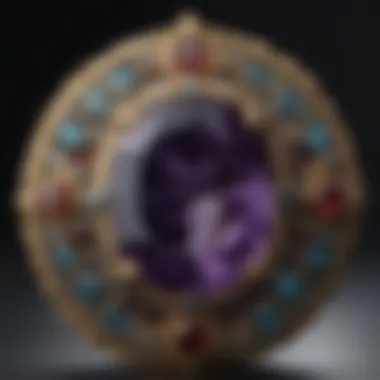
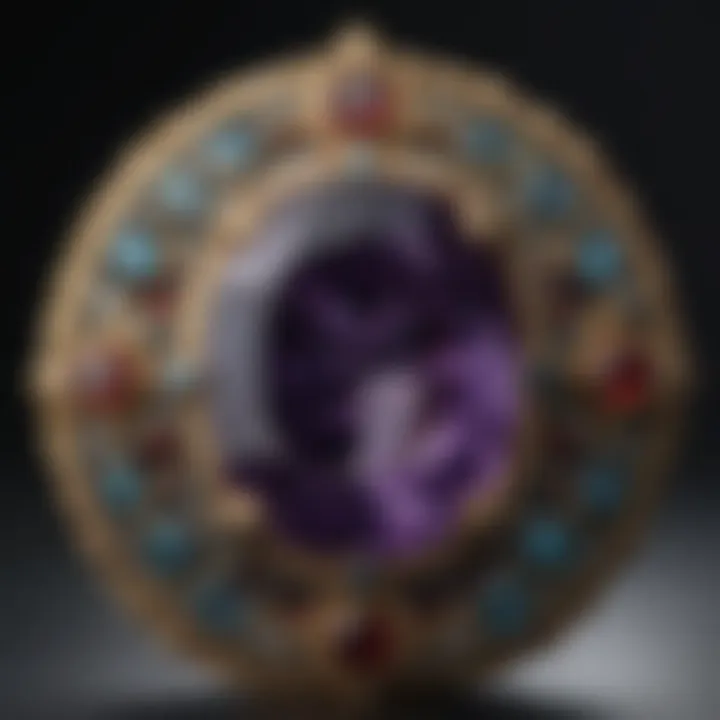
Understanding the market value and investment potential of cathedral cut gemstones is essential for collectors and enthusiasts alike. These gemstones often combine aesthetic allure with the promise of appreciation in value, making them an appealing investment choice. As potential buyers explore the realm of these unique cuts, awareness of the factors that influence their market value is crucial. This section dives deep into the elements of valuation, guiding readers on what contributes to the worth of cathedral cut gems, as well as how to navigate the complex landscape of gemstone investment.
Factors Affecting Value
Carat Weight
Carat weight is a significant factor that influences the value of cathedral cut gemstones. Essentially, carat weight refers to the size of the gem; a higher carat weight typically translates to a higher price. Larger stones are often rarer and more sought after, which can lead to increased market demand. Therefore, a well-crafted cathedral cut with a high carat weight tends to generate more interest among buyers. However, it’s important to remember that size does not always equate to value in a linear fashion. Other characteristics, such as the quality of the cut and the clarity of the stone, play a crucial role too. Larger stones may be available, but if they have flaws or are poorly cut, their value could take a hit.
Quality of Cut and Clarity
The quality of cut and clarity are two other pillars upholding the market value of cathedral cut gemstones. The artistry behind the cut can enhance a stone's ability to reflect light, creating breathtaking brilliance and fire. A well-executed cut shows precision and intention, often elevating the gemstone's appeal. Alongside that, clarity refers to the presence of internal or external flaws. A stone with higher clarity will generally command a better price because it showcases a clean, flawless appearance. Collectors often seek stones that demonstrate both superior cut quality and exceptional clarity to ensure their investment remains strong in the long run.
Evaluating Cathedral Cut Gemstones
As with any valuable asset, understanding how to assess cathedral cut gemstones is paramount for potential investors. Proper evaluation can help determine authenticity and fair market value. There are tools and processes available for both professional appraisals and individual assessments, and knowing them can empower buyers in their purchasing decisions.
Professional Appraisal Practices
Engaging a qualified gemologist for professional appraisal practices can significantly impact the acquisition process. Professionals leverage specialized knowledge and tools to accurately assess the value of cathedral cut gemstones. Their expertise includes various factors, such as gemstone grading standards, market fluctuations, and the latest trends in jewelry design. An appraisal can provide a detailed report, which authenticates the piece and outlines its attributes. While professionals typically charge for their services, the accuracy and consultation can save buyers from making uninformed decisions or investing in overpriced items.
DIY Evaluation Tips
For those who prefer a more hands-on approach, DIY evaluation tips can complement the professional services. Buyers can arm themselves with knowledge about how to examine a cathedral cut gemstone. This includes checking for proper symmetry, assessing light performance, and using a magnifier to inspect clarity. Having a basic understanding of gemstone quality standards allows buyers to identify good deals and potential red flags. While DIY evaluations can help guide initial choices, they shouldn’t replace professional assessments, especially for high-value purchases.
Current Market Trends
Keeping an eye on current market trends is vital for anyone interested in cathedral cut gemstones. Demand is often shaped by aesthetics, cultural influences, and consumer preferences. Understanding these trends helps buyers make informed investment choices.
Demand for Unique Cuts
The demand for unique cuts, such as cathedral cut gemstones, is steadily rising. Collectors seek out these gems for their distinctive appearance and architectural inspiration. Unique cuts often stand out in a crowded market, appealing to buyers who want something different from traditional shapes. Although these cuts may sometimes come with a higher price tag, their rarity and visual impact add to their allure.
Investment Opportunities
Finally, potential investment opportunities associated with cathedral cut gemstones are plentiful. As awareness of these unique gems increases, so does their market presence. The rise in demand translates to potential financial appreciation for collectors. New trends, collaborations with fashion designers, and interest from younger generations promise a bright future for cathedral cut gemstones in the investment landscape. Keeping track of emerging designers and limited editions can be particularly advantageous for savvy investors.
Overall, understanding market value and investment potential is a crucial aspect of engaging with cathedral cut gemstones. Whether you are a seasoned collector or a newcomer to the field, knowledge of carat weight, quality of cut, and current trends will inform your purchasing decisions, making every investment a well-thought-out one.
Care and Maintenance
Maintaining cathedral cut gemstones is crucial for preserving their beauty and structural integrity. The way you clean, store, and maintain these gems can influence their appearance and longevity. For those captivated by these unique stones, understanding regular care is essential. Improper treatment can lead to dullness, scratches, or even chipping.
Cleaning Techniques
Do's and Don'ts
Keeping your cathedral cut gems clean requires some basic knowledge.
Do's:
- Use a soft cloth: For routine cleaning, a soft microfiber cloth can help to gently wipe away dust and smudges.
- Use tepid water: When deeper cleaning is necessary, lukewarm water is effective. Always ensure that the water isn’t too hot, as thermal shock may cause fractures.
Don'ts:
- Avoid harsh chemicals: Acids and abrasive substances can scratch or even damage the stone.
- Steer clear of ultrasonic cleaners: While effective for other stones, these devices may be too harsh for cathedral cuts, risking structural damage.
By following these do's and don'ts, you can assure that your gemstones continue to shine bright without unnecessary risks.
Recommended Cleaning Solutions
When it comes to effective solutions for cleaning, simpler is often better.
- Mild soap solution: A few drops of mild dish soap mixed with water can break down grime while being gentle on the surface.
- Ammonia diluted in water: This can be effective for stubborn dirt but must be used sparingly to avoid any potential damage.
These solutions not only clean effectively but also keep the integrity of the stone intact. Avoiding strong commercial cleaners can save your gemstones from unintended harm.
Storage Recommendations
Storing cathedral cut gemstones properly is as important as cleaning them. How and where you store these gems can influence their longevity and appearance significantly.
Protecting from Damage
Mechanically speaking, certain precautions should be taken to prevent damage.
- Wrap in soft fabric: Using a soft cloth or microfiber pouch can protect the stones from scratches and other physical damage.
- Separate storage: Keeping each gemstone in its own compartment can prevent them from scratching against one another.
Safeguarding against damage contributes significantly to preserving the quality of your gems, which is a smart approach for any jewelry collector.
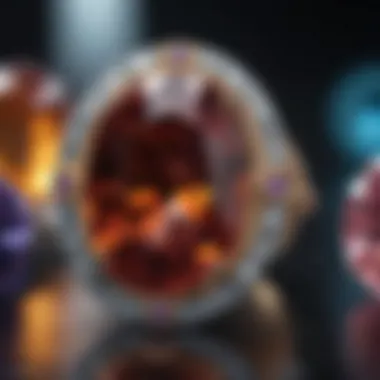
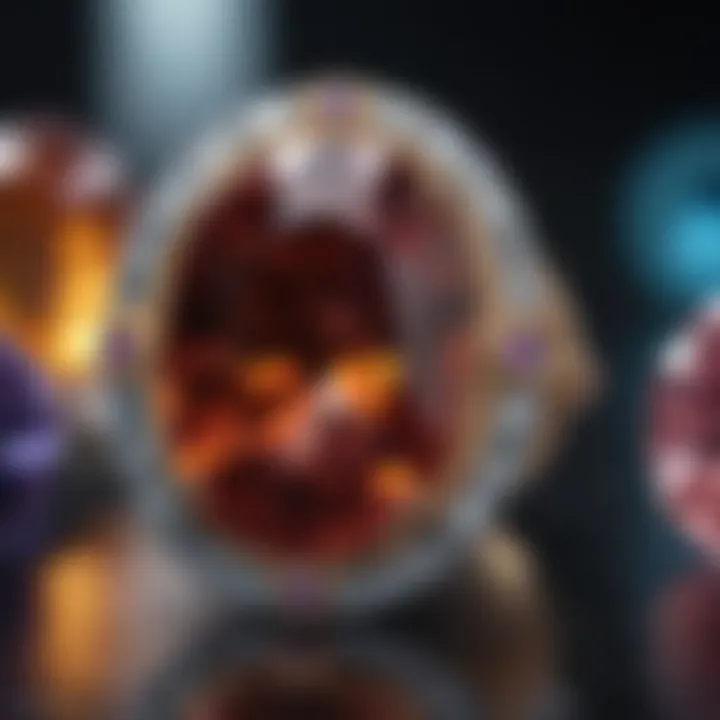
Best Storage Practices
Adopting recommended best practices for storage can prolong the lifespan of your cathedral cut gemstones.
- Climate control: Store gems in a climate-controlled environment to prevent humidity and temperature fluctuations, which can lead to deterioration.
- Use jewelry boxes with dividers: This keeps each piece organized and reduces the risk of tangling or scratching.
By being methodical in your approach to storage, you ensure that your gemstones remain in their prime condition for years to come.
Professional Maintenance
Even with diligent care, cathedral cut gemstones sometimes require professional intervention for the best upkeep. Regular professional maintenance can keep stones looking their finest.
Finding Qualified Jewelers
In seeking out a provider for maintenance, finding a qualified jeweler is paramount.
- Certification matters: Look for jewelers with certifications or credentials relevant to gemology. This often means they understand the unique needs of cathedral cuts.
- Reputation counts: Don’t hesitate to ask around or check reviews online platforms and forums like Reddit. An established jeweler with great feedback is usually a safe bet.
Choosing the right jeweler can help you maintain the value of your gemstones and ensure that they remain a dazzling centerpiece in your collection.
Understanding Maintenance Costs
It's also wise to get an understanding of the costs involved in maintaining cathedral cut gemstones.
- Routine vs. Occasional: Regular cleaning and check-ups may be more affordable than major repairs due to neglect. Understanding this difference can lead to long-term savings.
- Transparency: Opt for jewelers that provide clear estimates and explain their pricing structure.
Being informed of maintenance costs reinforces a careful approach to ownership. Knowing what you are getting into will save frustration later and keep your budget in check.
Following these care and maintenance tips can vastly increase the lifespan and beauty of your cathedral cut gemstones, ensuring that they remain cherished pieces for generations.
Common Myths and Misconceptions
Understanding the myths and misconceptions surrounding cathedral cut gemstones is vital for both enthusiasts and collectors. These misunderstandings can skew perceptions, potentially affecting decisions made when purchasing these unique pieces. When individuals harbor false beliefs about these gems, it can lead to undervaluation or, worse, discrediting this beautiful cut altogether.
By dissecting these myths, we can illuminate the truths that lie at the heart of the cathedral cut's design, significance, and value.
Debunking the Myths
Myth vs. Fact
One common myth is that cathedral cut gemstones are simply rebranded versions of other cuts, lacking any distinctive features of their own. This couldn't be further from the truth. Cathedral cut, with its linear, architectural lines, is derived from a deep appreciation for both artistry and technical precision. Its design echoes the grandeur of Gothic cathedrals, making each gemstone a unique masterpiece.
The key characteristic here is the structure of the cut—while it may share some similarities with other cuts, like the brilliant cut, it holds its own in terms of light performance and visual allure. Understanding this myth helps collectors recognize the unique value that cathedral cut stones bring to the table.
The unique feature of recognizing the distinction between cuts can be highly beneficial. It allows buyers to make informed choices and appreciate the craftsmanship that goes into creating a cathedral cut gemstone.
Understanding the Truths
Another prevalent misconception is the belief that cathedral cut gemstones are inferior in quality compared to more popular cuts such as the princess or radiant cuts. This idea often stems from a lack of understanding about how each cut interacts with light. Cathedral cuts can reflect and disperse light in a way that enhances the overall color and brilliance of the stone—not unlike the interplay of light within an actual cathedral.
The key characteristic of this truth lies in recognizing that the value of a gemstone is not only in its cut but also in the skill of the artisan who shapes it. This choice is essential because it encourages buyers to appreciate the artistic value behind these cuts.
Moreover, the unique feature here is that cathedral cuts can bring a different kind of elegance to a piece, one that resonates with those who appreciate architectural beauty. Understanding this puts the emphasis on aesthetics rather than popularity.
Impact of Misconceptions on Value
Misconceptions can have a significant impact on the perceived value of cathedral cut gemstones. When people believe that these stones lack the prestige of their more well-known counterparts, they might undervalue them when reselling or appraising. This undervaluation can lead not only to financial losses for sellers but also to missed opportunities for buyers looking for unique additions to their collections.
Furthermore, these myths can foster an environment where sales and purchases are driven more by trends rather than by appreciation for quality. A deeper understanding of cathedral cuts can help counteract the negative influence of these misconceptions, fostering a more informed marketplace.
“Understanding the myths and truths surrounding cathedral cut gemstones is not just about clarity in value, but elevating the appreciation of this art form.”
Culmination
As we draw the curtains on our exploration of cathedral cut gemstones, it's clear that their unique design and cultural significance are more than just ornamental aspects. These gemstones reflect a rich tapestry of history, artistry, and craftsmanship that captivates gem enthusiasts and collectors alike.
Summary of Key Insights
In summary, cathedral cut gemstones showcase a harmonious blend of artistic inspiration drawn from architectural marvels and a modern touch that appeals to today's jewelry lovers. Their exceptional ability to reflect light enhances the beauty of these stones, allowing them to stand out in various pieces. The journey through their historical context reveals a continuous evolution of design, reinforcing their position in both ancient and contemporary jewelry. Notably, the value of these gemstones is influenced by multiple factors, including cut quality, clarity, and overall demand in the market.
Looking Ahead
Future Trends in Cathedral Cut
Looking ahead, the cathedral cut appears poised to maintain its popularity as part of an ongoing trend towards unique and personalized styles in jewelry. The key characteristic of this trend is the increasing consumer preference for distinctive designs that tell a story. As more jewelry designers embrace this cut, we can expect to see innovative adaptations that blend traditional elements with modern aesthetics, heightening their desirability. One unique feature of these future trends is the integration of mixed media into jewelry designs, which can enhance the visual appeal of cathedral cut gemstones. This trend offers a myriad of benefits, from being conversation starters to ensuring that wearers stand out in a crowd.
Continued Importance in Gemology
In gemology, the cathedral cut holds enduring relevance not just for its beauty, but also for its technical intricacies. As collectors and enthusiasts gain a deeper understanding of various cuts, the cathedral cut's place in gemstone education remains pivotal. Its unique semetric qualities allow gems to exhibit multidimensional reflections, contributing significantly to discussions on light behavior in stones. This characteristic also teaches valuable lessons about selection, investment, and what to look for when evaluating gemstones. While the market fluctuates, the continuing appreciation for unique cuts like cathedral ensures that jewelers and collectors will always have a strong interest in this elegant format.
"The beauty of cathedral cut gemstones lies not only in their physical luster but also in the stories they whisper through history and design."
As we move forward, engaging with cathedral cut gems opens the door to further exploration and appreciation within the vast universe of gemology.



